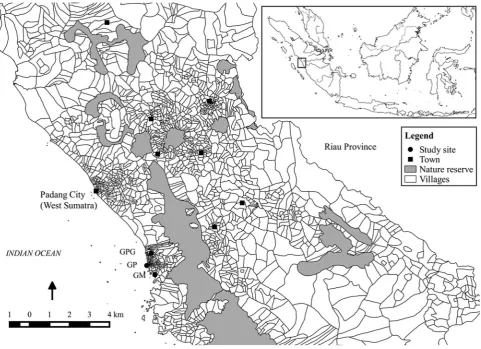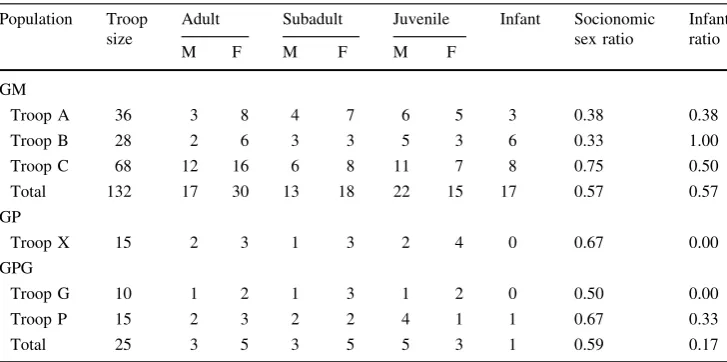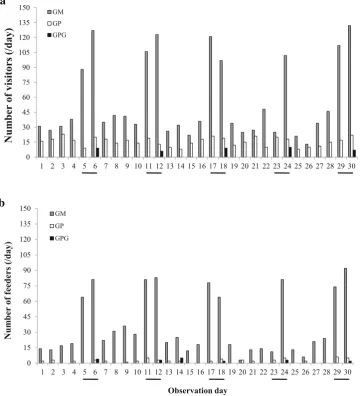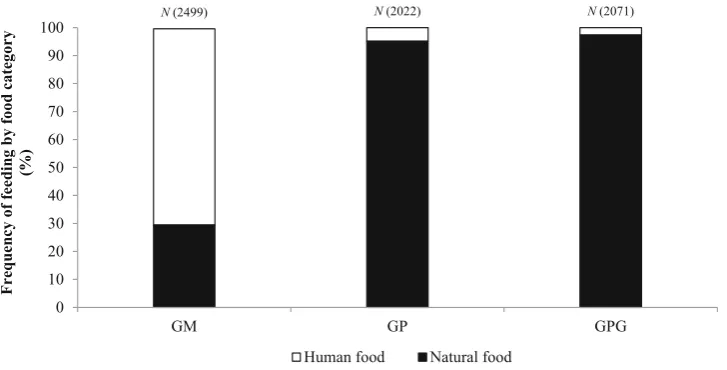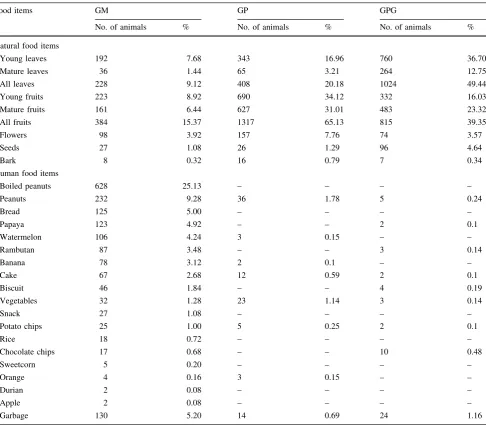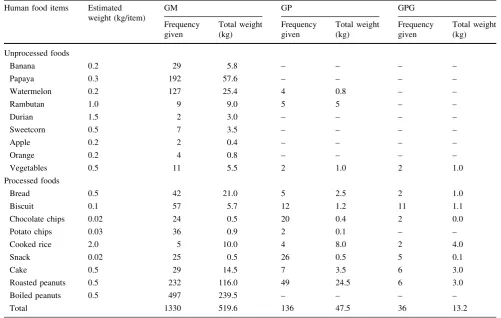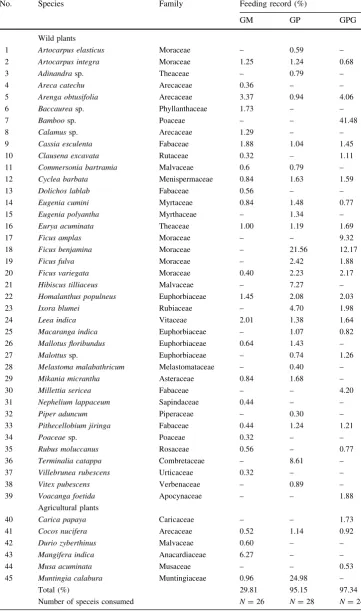1 23
Primates
ISSN 0032-8332
Primates
DOI 10.1007/s10329-016-0588-1
Status of urban populations of the
long-tailed macaque (
Macaca fascicularis
) in
West Sumatra, Indonesia
1 23
O R I G I N A L A R T I C L E
Status of urban populations of the long-tailed macaque (
Macaca
fascicularis
) in West Sumatra, Indonesia
Kurnia Ilham1•Rizaldi1•Jabang Nurdin1• Yamato Tsuji2
Received: 12 July 2016 / Accepted: 13 November 2016
ÓJapan Monkey Centre and Springer Japan 2016
Abstract We studied long-tailed macaque (Macaca fas-cicularis) populations in Padang, West Sumatra, Indonesia, focusing on the effect of human provisioning on their demography and dietary composition. We conducted a field survey at three sites in the city: Gunung Meru, Gunung Padang, and Gunung Panggilun. Mean troop size (range 28–68) and infant ratio (range 0.38–1.00) were greater in Gunung Meru, where the macaques have been highly provisioned, than at the other two study sites (troop size 10–15; infant ratio 0.00–0.33). The macaques at all sites consumed both natural and human foods, but dependence on the latter differed among sites: three-quarters of the diet of macaques in Gunung Meru consisted of human foods, while human foods comprised less than 5% of the macaque diet at the other sites. The ability of macaques to modify the proportion of human food is a behavioral flexibility that facilitates the survival of the long-tailed macaque in urban habitats. Without restrictions on provisioning, the degree of dependence of macaques on human foods and population size could increase, especially in Gunung Meru, and human–macaque conflict could escalate. In order to create an effective management policy for urbanized monkeys, long-term quantitative data on macaque behavior and monitoring of population parameters are required.
Keywords Demographic profiles DietLong-tailed macaqueProvisioningUrban habitat
Introduction
The long-tailed macaque (Macaca fascicularis) is a pri-mate species that is among the most tolerant of habitat disturbance by humans (Richard et al.1989; Fooden1995). These monkeys are predominantly found in evergreen forests, mangrove forests, swamp forests, riparian forests, and forest edges (Ong and Richardson 2008; Gumert
2011). Habitat loss due to logging, farming, and human housing have resulted in long-tailed macaques living in close proximity to humans in rural and urban environments (Hadi 2005; Gumert 2011; Aggimarangsee 2013). The ability of macaques to thrive in various habitat conditions or survive in a highly anthropogenic landscape depends on their ecological flexibility—their ability to adjust their diet, troop size, habitat use, and activity budgets (Hanya et al.
2003; Jaman and Huffman2013; Tsuji et al.2013). In general, food availability is the most important factor affecting the behavior of macaques (Fuentes et al. 2005; Tsuji et al. 2006; Jaman and Huffman2013). Long-tailed macaques are predominantly frugivorous, but they also consume a wide variety of plant and animal foods, including young and mature leaves, flowers, seeds, barks, fungi, insects, and small invertebrates—especially crus-taceans in mangroves (Fooden 1995; Yeager 1996). In anthropogenic habitats, they often shift their diet from natural foods to human foods (Hadi et al. 2007; Fuentes et al. 2011; Sha and Hanya2013). Human foods are more palatable, energy-rich, easily digestible, spatially clumped, and abundant, offering energetic advantages over natural ones (Forthman-Quick and Demment 1988; Iwamoto
1988).
The provisioning of human food to macaques can sig-nificantly affect their behavior: feeding time (including foraging) occupies most of the day in undisturbed
& Kurnia Ilham
ilham_primate@yahoo.co.id
1 Department of Biology, Andalas University, Padang,
West Sumatra 25163, Indonesia
2 Primate Research Institute, Kyoto University, 41-2 Kanrin,
Inuyama, Aichi 4848506, Japan Primates
environments or natural habitats, while time spent resting is more important in habitats with human foods (Asquith
1989; Saj et al.1999; El Alami et al.2012; Sha and Hanya
2013). Since human foods possess higher nutritional value, which is essential for basic health and breeding, females that feed on human food grow faster and mature earlier than females that do not consume such food (Wong1994; Iwamoto 1988). The utilization of human foods often increases the birth and survival rates of macaque infants and decreases their primiparous age (Sugiyama and Ohsawa 1982; Watanabe et al. 1992; Brotcorne 2014). Thus, the sizes of the troops with access to human foods are larger than those without access to human foods (Wheatley et al. 1996; Wong and Ni 2000; Malaivijitnond and Hamada 2008). This extended macaque troop size often causes potential conflicts between human and macaques (Sha et al.2009). From a social point of view, the presence of human food increases the degree of intragroup compe-tition over food, resulting in higher levels of social tension and anxiety (Mare´chal et al.2011; Sussman et al. 2011). Furthermore, human foods sometimes cause health issues and diseases in macaques (Aggimarangsee1992; Malaivi-jitnond et al.2011).
In Padang, West Sumatra, Indonesia, long-tailed macaque habitats have been fragmented by human habitation and farming. We identified three urban pop-ulations of long-tailed macaques in Gunung Meru, Gunung Padang, and Gunung Panggilun. The macaques in Gunung Meru seem to have been provisioned by humans for more than 200 years (Koyama 1984). Information on the macaque populations in Gunung Padang and Gunung Panggilun is scarce, and the degree of provisioning there is unclear. The aim of the study reported in the present paper was therefore was to assess the behavioral ecology of long-tailed macaques in Padang. As ecobehavioral parameters, we focused on the demographic profiles and diet compositions of these three populations of long-tailed macaques. Such quanti-tative data should lead to a better understanding of the dietary plasticity and the population parameters of the long-tailed macaques living in urban areas. Demographic studies play a paramount role in primate conservation biology, particularly given the need to estimate the status and trends of populations in order to develop appropriate conservation and management action.
Methods
Study site
The study was conducted in Padang, West Sumatra, Indonesia (Fig.1). We conducted a field survey at three
sites: Gunung Meru (hereafter GM, 01°00024.7500S and
100°23014.000E), Gunung Padang (GP, 0°57056.600S and
100°20056.500E), and Gunung Panggilun (GPG, 0°54035.900S
and 100°2209.400E). These three sites are located on small
mountains (altitude range 76–200 m). Each site encom-passes ca. 2 ha of secondary forest surrounded by roads and human settlements. Dominant plants at these sites includeFicus elastica,F. benjamina(Moraceae),Alstonia scholaris (Apocynaceae), Cocos nucifera,Arenga obtusi-folia(Arecaceae), andEurya acuminate (Theaceae), but a detailed vegetation survey of these sites has not been conducted.
Data collection
There were three macaque troops (troops A, B, and C) at GM, one troop (X) at GP, and two troops (G and P) at GPG. During the observation period, we attempted to count the number of animals in each troop. We classified each animal into one of six age classes based on morphological characteristics such as body size, developmental stage of sexual organs, and skin color (Poirier and Smith 1974). Male long-tailed macaques reach sexual maturity at approximately 6 years of age, whereas female maturity occurs at about 4 years of age (Fooden 1995). We classi-fied the macaques into adult males ([5 years), adult
females ([4 years), subadult males and females
(3.5–4 years), juveniles (1–3 years), and infants (\1 year).
We summed the troop sizes for each study site to obtain the overall population size. We calculated (1) socionomic sex ratio (adult male/adult female), an indicator of sex ratio skewness, and (2) infant ratio (infant/adult female), an indicator of crude birth rate (Kyes 1993), for each troop. During the study period (October 2015 to February 2016), we counted the number of animals 20 times for troop A, 18 times for troop B, 30 times for troop C, 30 times for troop X, 30 times for troop G, and 15 times for troop P, and employed the maximum number as the size of the given troop. Due to the short study duration, we may have underestimated the birth rate: we could not detect infants born in January 2015 but died before October 2015.
GPG were 9.3±0.6, 8.5±0.6, and 9.2±1.1 h, respectively.
The climate (in terms of temperature and monthly rainfall) in Padang during this study was stable (range of maximum temperature 32.3–33.9, minimum temperature 23.3–24.0, rainfall 104–510 mm, www.accuweather.com, accessed on 07/02/2016), so we did not consider seasonal changes in diet availability and number of visitors.
During the observation period, we conducted 5-min scan sampling at 10-min intervals and recorded the activities of all visible animals (except for infants). If the scanned animals were foraging, we recorded the type of food (natural or human) and parts eaten. The parts were classi-fied as young leaves, mature leaves, young fruits, mature fruits, flower, bark, or seeds.
We recorded the number of tourists during the obser-vations. We also recorded provisioning events (defined as events in which a tourist fed a monkey manually) by ad libitum sampling for 15 min. We treated two provi-sioning events occurring[15 min apart as different events.
Provisioned foods were classified as processed (boiled, baked, or fried) or unprocessed foods. Whenever we
observed a provisioning event, we took photographs to identify the item, from which we estimated the weight of the provisioned food. If possible, we asked the feeders directly about the type of food. The amount of provisioned foods during the observation was estimated by multiplying the weight of each food item by the number of provisioning events. We estimated foods provisioned per capita by dividing the total amount of human food by the total number of monkeys at a given site during the study period.
Statistical analyses
In order to assess the differences in the number of visitors per day among the study sites, we conducted the Kruskal– Wallis test and post-hoc tests with Bonferroni adjustment. In order to compare the degree of provisioning (no. of feeders/no. of visitors) and dietary composition among the study sites, we conducted a chi-square test of independence for the pooled data over the 30-day survey. Statistical analyses were performed using R ver. 3.2.3 (R Develop-ment Core Team 2016). The statistical significance level (a) was set as 0.05.
Results
Population structure and age-sex ratios
The three population studies of long-tailed macaques comprised 172 individuals (Table1). The largest popula-tion was found at GM, with 132 individuals in three troops (A, B, and C). The mean±SD troop size at GM was 44.0±21.1. In GP, the troop (X) was composed of 15 individuals. In GPG, we counted 25 individuals in two troops (G and P), and the mean troop size was 12.5±2.1. Overall, the age structure of the populations was 35% adults, 25% subadults, 30% juveniles, and 10% infants. The mean socionomic sex ratios of the population at GM, GP, and GPG were 0.57, 0.67, and 0.59, respectively, and all were skewed towards females. The infant ratio ranged from 0.00 to 1.00 and was highest at GM. There were no infants in troops X and G (Table1).
Intensity of human provisioning
The number of visitors significantly differed among the study sites (Kruskal–Wallis test: v2=78, df=2, p\0.001, Fig.2a). Post-hoc tests revealed that the
num-ber of visitors at GM was significantly greater than those at the other two sites (p\0.001). The number of tourists at
GM was greater during holidays, whereas such differences were not observed at GP and GPG. The number of feeders also differed significantly among the sites (v2=66, df=2, p\0.001), and was significantly higher at GM
(p\0.001, Fig.2b). In addition, there were significant
differences in the degree of human provisioning among the three study sites, with the highest degree occurring at GM (v2=152,df=2,p\0.001). At GM, both the number of
visitors and the number of feeders peaked during weekends and holidays (Fig.2).
At GM, the total amount of food provisioned during the study was approximately 519.6 kg (mean±SD: 129.8±10.4 kg/week; ca. 0.98 kg per capita). In GP, the total amount of food provisioned was 47.5 kg (8.3±1.9 kg/week; ca. 0.53 kg per capita). In GPG, the total amount of food provisioned was approximately 13.2 kg (3.5±1.3 kg/week; ca. 0.14 kg per capita). The quantity and type of food provided to the macaques at each study site are shown in Table3inAppendix 1.
Food selection and diet composition
During the study period, the macaques consumed both nat-ural and human foods (Fig.3; Table2). At GM, the per-centage of human food in the macaque diet was 70.19%, while the corresponding values at GP and GPG were 4.85 and 2.66%, respectively. The percentage of human food differed significantly among sites (v2=3394, df=2, p\0.001).
The macaques’ natural food consisted only of plant species. We recorded 45 plant species eaten by the macaques at the three study sites. The numbers of plant species eaten by the macaques at GM, GP, and GPG were 26, 28, and 24, respectively (Table4 in Appendix 2). Most plant species consumed by the macaques at the three study sites were wild plants (Table4inAppendix 2). The composition of natural food items consumed by the macaques significantly differed among the study sites (v2=509, df=8,p\0.001). The
dietary percentages of leaves and fruits at GPG and GP were higher than those at GM (Table2). In terms of human foods, the dietary percentages of boiled peanuts, peanuts, and foods taken from garbage bins at GM were much higher than those at the other sites (Table2).
Table 1 Demographic structure and socionomic sex ratio of the long-tailed macaque population at each of the three sites considered during the study period
Population Troop size
Adult Subadult Juvenile Infant Socionomic sex ratio
The table presents the number of individuals in each age-sex category within each troop during the observation period
Discussion
The troop size of GM (range 28–68) was much larger than those of GP (15) or GPG (10–15). Due to their higher nutritional value and higher digestibility, human foods are high-quality foods for primates (Wong 1994; Iwamoto
1988). Thus, an abundance of human food provided to macaques is likely to increase their carrying capacity in a given habitat (Dobson and Lees 1989; Crockett et al.
1996), and long-term provisioning causes an increase in troop size. Troop sizes of long-tailed macaques in urban areas sometimes exceed 100 individuals (Aggimarangsee
1992; Brotcorne 2009), while those in forested habitats range from 12 to 30 (van Schaik and van Noordwijk1985; Wheatley et al.1996). The larger numbers at GM can be
attributed to the long-term provisioning there. On the other hand, the troop sizes of GP and GPG are comparable to those of the wild population, and the degree of provisioning at those sites at present is slight.
Effects of provisioning are often reflected in the socio-nomic sex ratio and/or birth ratio. Fooden (1995) reported the range of socionomic sex ratios in the wild population to be 0.22–0.90. At the troop level, the corresponding values range from 0.15 to 0.6 (Wheatley et al.1996). Socionomic sex ratios of long-tailed macaques at our study sites (range: 0.33-0.75) were within the range of the wild populations mentioned above (Wheatley et al.1996), indicating that the socionomic sex ratio of these macaques is a relatively conservative feature related to female philopatry and male emigration from natal troops (van Noordwijk and van 0
Fig. 2 aNumber of visitors per day at each study site.bNumber of feeders per day at each study site.Gray barsGunung Meru,open bars
Schaik1999). Among our study sites, the infant ratio of the macaques was particularly high at GM (0.57). This ratio is similar to that of long-tailed macaques in Ubud, Bali: when highly provisioned, their infant ratio was 0.53, indicating that half of the adult females had infants (Brotcorne2009). The stability of the human food provided to the macaques can explain the high birth rate at GM. It has been docu-mented that provisioned females grow faster, mature ear-lier, and have shorter interbirth intervals than those in nonprovisioned populations (Sugiyama and Ohsawa1982; Asquith 1989; Watanabe et al.1992; van Noordwijk and van Schaik 1999; Altman and Albert 2005). The infant ratio at GM indicates that provisioning affected the reproductive performance of the macaques.
Our study showed that the number of feeders greatly differed among the sites: at GM, the number of feeders per month was more than 1000, and the per capita food was 0.98 kg; this is comparable to the highly provi-sioned population of rhesus macaques (Macaca mulatta) in Kowloon Hills, Hong Kong (3066 casual feeders per month, per capita provisioned food: 1.1 kg) (Wong
1994). On the other hand, provisioning at GP and GPG was occasional, and the per capita provisioned food was lower (0.14–0.55 kg). This implies that artificial effects are much greater at GM. Koyama (1984) mentioned that the reason for provisioning at GM was related to the religious context: there were graves of mythical Muslim warriors nearby, and people treat the monkeys as incarnations of the warriors and therefore feed them. GM has become a famous tourist site in Padang, and tourists feed the monkeys not only as a traditional offering but also for entertainment. Koyama (1984) showed no quantitative data on provisioning in GM, but our results
implied that provisioning at this site has been done regularly. These macaques receive food directly from humans or from garbage.
The macaques at our study sites fed on both human and natural foods, but the percentages differed greatly among sites, with the highest dietary percentage of human food found at GM. The dietary percentage of human foods depends on their availability, which is proportional to the number of tourists (feeders) (Brotcorne 2014). In the case of long-tailed macaques in Singapore, 49% of the food consumed by the high-anthropogenic troop was human food, whereas this percentage was less than 26% for the low-anthropogenic troop (Sha and Hanya 2013). Our results supported that finding. The ability to adjust their dependence on human food resources seems to be a behavioral flexibility of long-tailed macaques living in urban habitats.
The natural diet of macaques consists mainly of fruits, leaves, seeds, flowers, and bark. However, dietary com-position differed among the sites. The macaques at GM and GP fed primarily on fruits, while the macaques at GPG consumed more leaves. Intraspecific variation in the pro-portions of different plant parts in the diet can be attributed to natural food availability (Hill1997; Hanya2004; Tsuji et al. 2013). For example, Muntingia calabura, Ficus benjamina, andArenga obtusifoliatrees grow rapidly and produce fruit throughout the year. Therefore, the macaques at GM and GP may have relied more on their fruit. On the other hand, at GPG, the forest was dominated by bamboo trees and there were fewer fruit trees, which may have caused the macaques to be more folivorous. To test this hypothesis, a detailed vegetation survey should be con-ducted in the future.
N (2499) N (2022) N (2071)
Human food Natural food
Our results confirmed that a dietary shift to human food is one of the adaptive mechanisms of macaques in urban environments. Our results indicate that if the present situ-ation continues, the populsitu-ation of long-tailed macaques at GM will continue to grow. If a restriction on feeding is not initiated by the local government, serious human–macaque conflicts such as crop raiding and aggressive behavior toward visitors will likely occur in the near future. Fur-thermore, human foods cause health issues and diseases in macaques (Aggimarangsee 1992; Malaivijitnond et al.
2011; Wheatley et al. 1996), which can have a serious impact on their survival. Continuous monitoring of
long-tailed macaque behavior and regular population surveys are necessary to fully understand their population status, and would provide the scientific data required to create an efficient management plan for the macaques in Padang.
Acknowledgements We would like to thank the staff of the Department of Biology of Andalas University and the Primate Research Institute, Kyoto University, for supporting our research; the people of Gunung Meru, Gunung Padang, and Gunung Panggilun for their contributions and accommodations during the fieldwork; the staff of the Herbarium at Andalas University for their assistance with plant identification; and members of the Museum of Zoology at Andalas University for their assistance during data collection. Table 2 Comparison of plant parts and human food items consumed by macaques at three study sites in West Sumatra: Gunung Meru (GM), Gunung Padang (GP), and Gunung Panggilun (GPG)
Food items GM GP GPG
No. of animals % No. of animals % No. of animals %
Natural food items
Young leaves 192 7.68 343 16.96 760 36.70
Mature leaves 36 1.44 65 3.21 264 12.75
All leaves 228 9.12 408 20.18 1024 49.44
Young fruits 223 8.92 690 34.12 332 16.03
Mature fruits 161 6.44 627 31.01 483 23.32
All fruits 384 15.37 1317 65.13 815 39.35
Flowers 98 3.92 157 7.76 74 3.57
Seeds 27 1.08 26 1.29 96 4.64
Bark 8 0.32 16 0.79 7 0.34
Human food items
Boiled peanuts 628 25.13 – – – –
Peanuts 232 9.28 36 1.78 5 0.24
Bread 125 5.00 – – – –
Papaya 123 4.92 – – 2 0.1
Watermelon 106 4.24 3 0.15 – –
Rambutan 87 3.48 – – 3 0.14
Banana 78 3.12 2 0.1 – –
Cake 67 2.68 12 0.59 2 0.1
Biscuit 46 1.84 – – 4 0.19
Vegetables 32 1.28 23 1.14 3 0.14
Snack 27 1.08 – – – –
Potato chips 25 1.00 5 0.25 2 0.1
Rice 18 0.72 – – – –
Chocolate chips 17 0.68 – – 10 0.48
Sweetcorn 5 0.20 – – – –
Orange 4 0.16 3 0.15 – –
Durian 2 0.08 – – – –
Apple 2 0.08 – – – –
Garbage 130 5.20 14 0.69 24 1.16
Appendix 1
See Table3.
Table 3 Quantity of provisioned foods from October 2015 to February 2016 at three study sites in West Sumatra: Gunung Meru (GM), Gunung Padang (GP), and Gunung Panggilun (GPG)
Human food items Estimated weight (kg/item)
GM GP GPG
Frequency given
Total weight (kg)
Frequency given
Total weight (kg)
Frequency given
Total weight (kg)
Unprocessed foods
Banana 0.2 29 5.8 – – – –
Papaya 0.3 192 57.6 – – – –
Watermelon 0.2 127 25.4 4 0.8 – –
Rambutan 1.0 9 9.0 5 5 – –
Durian 1.5 2 3.0 – – – –
Sweetcorn 0.5 7 3.5 – – – –
Apple 0.2 2 0.4 – – – –
Orange 0.2 4 0.8 – – – –
Vegetables 0.5 11 5.5 2 1.0 2 1.0
Processed foods
Bread 0.5 42 21.0 5 2.5 2 1.0
Biscuit 0.1 57 5.7 12 1.2 11 1.1
Chocolate chips 0.02 24 0.5 20 0.4 2 0.0
Potato chips 0.03 36 0.9 2 0.1 – –
Cooked rice 2.0 5 10.0 4 8.0 2 4.0
Snack 0.02 25 0.5 26 0.5 5 0.1
Cake 0.5 29 14.5 7 3.5 6 3.0
Roasted peanuts 0.5 232 116.0 49 24.5 6 3.0
Boiled peanuts 0.5 497 239.5 – – – –
Total 1330 519.6 136 47.5 36 13.2
Appendix 2
See Table4.
Table 4 List of natural foods consumed by long-tailed macaques between October 2015 and February 2016 at three study sites in West Sumatra: Gunung Meru (GM), Gunung Padang (GP), and Gunung Panggilun (GPG)
No. Species Family Feeding record (%)
GM GP GPG
Wild plants
1 Artocarpus elasticus Moraceae – 0.59 – 2 Artocarpus integra Moraceae 1.25 1.24 0.68 3 Adinandrasp. Theaceae – 0.79 – 4 Areca catechu Arecaceae 0.36 – – 5 Arenga obtusifolia Arecaceae 3.37 0.94 4.06 6 Baccaureasp. Phyllanthaceae 1.73 – –
7 Bamboosp. Poaceae – – 41.48
8 Calamussp. Arecaceae 1.29 – –
9 Cassia esculenta Fabaceae 1.88 1.04 1.45 10 Clausena excavata Rutaceae 0.32 – 1.11 11 Commersonia bartramia Malvaceae 0.6 0.79 – 12 Cyclea barbata Menispermaceae 0.84 1.63 1.59 13 Dolichos lablab Fabaceae 0.56 – – 14 Eugenia cumini Myrtaceae 0.84 1.48 0.77 15 Eugenia polyantha Myrthaceae – 1.34 – 16 Eurya acuminata Theaceae 1.00 1.19 1.69
17 Ficus amplas Moraceae – – 9.32
18 Ficus benjamina Moraceae – 21.56 12.17 19 Ficus fulva Moraceae – 2.42 1.88 20 Ficus variegata Moraceae 0.40 2.23 2.17 21 Hibiscus tilliaceus Malvaceae – 7.27 – 22 Homalanthus populneus Euphorbiaceae 1.45 2.08 2.03 23 Ixora blumei Rubiaceae – 4.70 1.98 24 Leea indica Vitaceae 2.01 1.38 1.64 25 Macaranga indica Euphorbiaceae – 1.07 0.82 26 Mallotus floribundus Euphorbiaceae 0.64 1.43 – 27 Malottussp. Euphorbiaceae – 0.74 1.26 28 Melastoma malabathricum Melastomataceae – 0.40 – 29 Mikania micrantha Asteraceae 0.84 1.68 – 30 Millettia sericea Fabaceae – – 4.20 31 Nephelium lappaceum Sapindaceae 0.44 – – 32 Piper aduncum Piperaceae – 0.30 – 33 Pithecellobium jiringa Fabaceae 0.44 1.24 1.21
34 Poaceaesp. Poaceae 0.32 – –
35 Rubus moluccanus Rosaceae 0.56 – 0.77 36 Terminalia catappa Combretaceae – 8.61 – 37 Villebrunea rubescens Urticaceae 0.32 – – 38 Vitex pubescens Verbenaceae – 0.89 – 39 Voacanga foetida Apocynaceae – – 1.88
Agricultural plants
40 Carica papaya Caricaceae – – 1.73 41 Cocos nucifera Arecaceae 0.52 1.14 0.92 42 Durio zyberthinus Malvaceae 0.60 – – 43 Mangifera indica Anacardiaceae 6.27 – – 44 Musa acuminata Musaceae – – 0.53 45 Muntingia calabura Muntingiaceae 0.96 24.98 –
Total (%) 29.81 95.15 97.34
Number of speceis consumed N=26 N=28 N=24
References
Aggimarangsee N (1992) Survey for semi-tame colonies of macaques in Thailand. Nat Hist Bull Siam Soc 40:103–166
Aggimarangsee N (2013) Status monitoring of isolated populations of macaques and other nonhuman primates in Thailand. In: Marsh LK (ed) Primates in fragments: ecology and conservation. Springer, New York, pp 147–158
Altman J, Albert SC (2005) Growth rates in a wild primate population: ecological influences and maternal effects. Behav Ecol Sociobiol 57:490–501
Asquith PJ (1989) Provisioning and the study of free-ranging primates: history, effects, and prospects. Am J Phys Anthropol 32:129–158
Brotcorne F (2009) Behavioral ecology of commensal long-tailed macaque (Macaca fascicularis) populations in Bali (Indonesia): comparison with previous data. Foreign Research Permit no: 0232/FRP/SM/IX/09: final report. University of Liege, Liege Brotcorne F (2014) Behavioral ecology of commensal long-tailed
macaque (Macaca fascicularis) populations in Bali (Indonesia). Doctoral thesis. University of Liege, Liege
Crockett CM, Kyes RC, Sajuthi D (1996) Modeling managed monkey populations: sustainable harvest of long-tailed macaques on a natural habitat island. Am J Primatol 40:343–360
Dobson AP, Lees A (1989) The population dynamics and conserva-tion of primate populaconserva-tions. Cons Biol 3:362–380
El Alami A, van Lavieren E, Rachida A, Chait A (2012) Differences in activity budgets and diet between semiprovisioned and wild-feeding groups of the endangered Barbary macaque (Macaca sylvanus) in the Central High Atlas Mountains, Morocco. Am J Primatol 74:210–216
Fooden J (1995) Systematic review of Southeast Asian long-tailed macaques,Macaca fascicularis (Raffles, 1821). Fieldiana Zool 81:1–206
Forthman-Quick DL, Demment MW (1988) Dynamics of exploita-tion: differential energetic adaptations of two troops of baboons to recent human contact. In: Fa JE, Southwick CH (eds) Ecology and behaviour of food enhanced primate groups. AR Liss, New York, pp 25–51
Fuentes A, Southern M, Suaryana KG (2005) Monkey forests and human landscapes: is extensive sympatry sustainable forHomo sapiens and Macaca fascicularis on Bali? In: Patterson JD, Wallis J (eds) Commensalism and conflict: the primate–human interface. American Society of Primatologists, Norman, pp 165–195
Fuentes A, Rompis AL, Putra IGAA, Watiniasih NL, Suartha IN, Soma IG, Selamet W (2011) Macaque behavior at the human– monkey interface: the activity and demography of semi-free-rangingMacaca fascicularisat Padangtegal, Bali, Indonesia. In: Gumert MD, Fuentes A, Jones-Engel (eds) Monkeys on the edge: ecology and management of long-tailed macaques and their interface with humans. Cambridge University Press, Cambridge, pp 159–179
Gumert MD (2011) The common monkey of Southeast Asia: long-tailed macaque populations, ethnophoresy, and their occurrence in human environments. In: Gumert MD, Fuentes A, Jones-Engel L (eds) Monkeys on the edge: ecology and management of long-tailed macaques and their interface with humans. Cambridge University Press, Cambridge, pp 3–44
Hadi I (2005) Distribution and present status of long-tailed macaques (Macaca fascicularis) in Lombok Island, Indonesia. Nat Hist J Chula UnivSup 1:90
Hadi I, Suryobroto B, Perwitasari-Farajallah D (2007) Food prefer-ence of semi-provisioned macaques based on feeding duration and foraging party size. Hayati J Biosci 14:13–17
Hanya G (2004) Seasonal variations in the activity budget of Japanese macaques in the coniferous forest of Yakushima: effects of food and temperature. Am J Primatol 63:165–177
Hanya G, Noma N, Agetsuma N (2003) Altitudinal and seasonal variations in the diet of Japanese macaques in Yakushima. Primates 44:51–59
Hill DA (1997) Seasonal variation in the feeding behavior and diet of Japanese macaques (Macaca fuscata yakui) in lowland forest of Yakushima. Am J Primatol 43:305–320
Iwamoto T (1988) Food and energetics of provisioned wild Japanese macaques (Macaca fuscata). In: Fa JE, Southwick CH (eds) Ecology and behavior of food-enhanced primate groups. AR Liss, New York, pp 79–84
Jaman MF, Huffman MA (2013) The effect of urban and rural habitats and resource type on activity budgets of commensal rhesus macaques (Macaca mulatta) in Bangladesh. Primates 54:49–59
Koyama N (1984) Socio-ecological study of the crab-eatings at Gunung Meru, West Sumatra. Kyoto Univ Overseas Res Rep Asian Non Human Primates 4:105–126
Kyes RC (1993) Survey of the long-tailed macaques introduced onto Tinjil Island, Indonesia. Am J Primatol 31:77–83
Malaivijitnond S, Hamada Y (2008) Current situation and status of long-tailed macaques (Macaca fascicularis) in Thailand. Nat Hist J Chula Univ 8:185–204
Malaivijitnond S, Vazquez Y, Hamada Y (2011) Human impact on long-tailed macaques in Thailand. In: Gumert MD, Fuentes A, Jones-Engel L (eds) Monkeys on the edge: ecology and management of long-tailed macaques and their interface with humans. Cambridge University Press, Cambridge, pp 118–156 Mare´chal L, Semple S, Majolo B, Qarro M, Heistermann M,
MacLarnon A (2011) Impacts of tourism on anxiety and physiological stress levels in wild male Barbary macaques. Biol Cons 144:2188–2193
Ong P, Richardson M (2008)Macaca fascicularis. In: IUCN (2010) IUCN Red List of Threatened Species, ver 2010.4. IUCN, Gland Poirier FE, Smith EO (1974) The crab-eating macaques (Macaca fascicularis) of Angaur Island, Palau, Micronesia (part 2 of 2). Folia Primatol 22:283–306
Richard AF, Goldstein SJ, Dewar RE (1989) Weed macaques: the evolutionary implications of macaque feeding ecology. Int J Primatol 10:569–594
Saj T, Sicotte P, Paterson JD (1999) Influence of human food consumption on the time budget of vervets. Int J Primatol 20:977–994
Sha JCM, Hanya G (2013) Diet, activity, habitat use, and ranging of two neighboring groups of food-enhanced long-tailed macaques (Macaca fascicularis). Am J Primatol 75:581–592
Sha JCM, Gumert MD, Lee BPH, Jones-Engel L, Chan S, Fuentes A (2009) Macaque–human interactions and the societal perceptions of macaques in Singapore. Am J Primatol 71:825–839 Sugiyama Y, Ohsawa H (1982) Population dynamics of Japanese
monkeys with special reference to the effect of artificial feeding. Folia Primatol 39:238–263
Sussman RW, Shaffer CA, Guidi L (2011) Macaca fascicularisin Mauritius: implications for macaque–human interactions and for future research on long-tailed macaques. In: Gumert MD, Fuentes A, Jones-Engel L (eds) Monkeys on the edge: ecology and management of long-tailed macaques and their interface with humans. Cambridge University Press, Cambridge, pp 207–235 R Development Core Team (2016) R: a language and environment for
statistical computing, ver 3.2.3. R Foundation for Statistical Computing, Vienna
macaques on Kinkazan Island, northern Japan. Am J Primatol 68:1068–1080
Tsuji Y, Hanya G, Grueter CC (2013) Feeding strategies of primates in temperate and alpine forests: comparison of Asian macaques and colobines. Primates 54:201–215
van Noordwijk MA, van Schaik CP (1999) The effects of dominance rank and group size on female lifetime reproductive success in wild long-tailed macaques, Macaca fascicularis. Primates 40:105–130
van Schaik CP, van Noordwijk MA (1985) Male migration and rank acquisition in wild long-tailed macaques (Macaca fascicularis). Anim Behav 33:849–861
Watanabe K, Mori A, Kawai M (1992) Characteristic features of the reproduction of Koshima monkeys,Macaca fuscata fuscata: a summary of thirty-four years of observation. Primates 33:1–32
Wheatley BP, Harya Putra IDK, Gonder MK (1996) A comparison of wild and food-enhanced long-tailed macaques (Macaca fascic-ularis). In: Fa JE, Lindburg DG (eds) Evolution and ecology of macaques societies. Cambridge Univ Press, Cambridge, pp 182–204
Wong CL (1994) Studies on the feral macaques of Hong Kong. Master’s thesis. Hong Kong University of Science and Tech-nology, Hong Kong
Wong CL, Ni IH (2000) Population dynamics of the feral macaques in the Kowloon Hills of Hong Kong. Am J Primatol 50:53–66 Yeager CP (1996) Feeding ecology of the long-tailed macaque
(Macaca fascicularis) in Kalimantan Tengah, Indonesia. Int J Primatol 17:51–62
